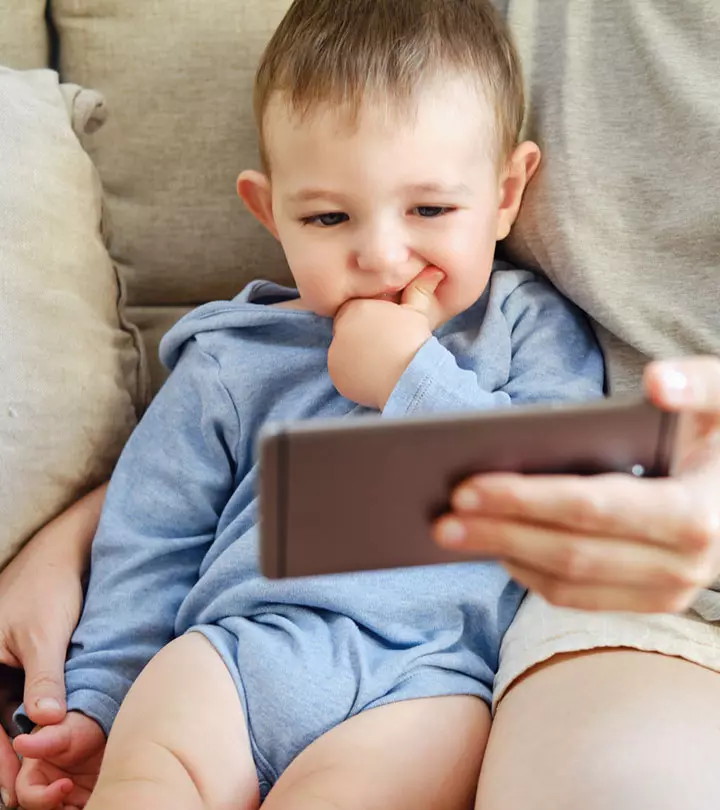
Image: Shutterstock
New parents come from a technologically advanced generation. They’ve always had technology around them and therefore see no harm in simply handing a device to their kids, even if they are barely old enough to grab onto a phone. If you’ve ever ventured out on a sunday afternoon, you’ve probably seen moms grocery shopping while their little one’s are busy staring at an ipad. Sure it does the trick of keeping them distracted and keeps tantrums at bay. But at what cost? Exposure to electronic devices can have many harmful effects on children such as their visual development as well as their cognitive and social development. The earlier your child gets addicted to staring at a screen, the worse for them. If you want to learn more about why screens are harmful for your little one and what they can do to keep themselves entertained instead, then keep on reading!
Visual Development Of Children
To understand why screens have such an impact on little kids, we need to understand how their visual development works. The human eye develops through stimulation and the quality of the optical stimuli is what is responsible for the growth of the eyeball. When your baby is just delivered, their eyes are hyperopic, which means that their power is not fully adjusted to the size of their eyes. An infant sees at short distances and can barely make out a shadow when you walk into the room or wave out to them. But during the first few weeks their eye size grows and with it, their retinas mature.
This way a balance is established between the size of the eyeball and the power of the inner lens. And by 6 months old your little one will already have the eyesight of an adult. Then their eyes will start developing the ability to coordinate which can lead them to generate three dimensional vision. But this is also the critical time during which the communication between the eyes starts to develop in the visual brain. This process consists of billions of neurological connections being made during the first 8 years of your little one’s life. This maturation period may seem long but it is also necessary. Keep in mind that more than a third of the brain’s neurons are dedicated to vision alone, so you don’t want to do anything that might jeopardize this process.
It’s A Question Of Distance
Why is allowing them to stare at a screen so detrimental to their eyesight? Well, electronic devices are not the source of the problem. But the inappropriate use of these devices is what often interferes with the visual development of the eye which includes the ability to read and other learning skills. Distances that are too short can influence the quality of your infant’s retinal image and can cause excessive eye fatigue. Eyes automatically converge towards the nose when they need to clearly view an image at a short distance. But if too much time is spent accommodating short distance images then there is a risk of greater than normal convergence taking place. Your baby’s eyes can’t prolong the effort to focus on this image for long periods of time and so, it will become blurry. This is a sensory penalty that will adversely affect the visual development of their eyes. Their eyes will shift from blurry to clear as their pupils relax and refocus on the image which can cause a lot of strain to the eyes. This is why any device has to be kept at least a forearm away from them, that is, at least 30 cm away from them. However, most babies and kids tend to hold the device close to their eyes which can cause many issues.
What To Do Instead?
In order to facilitate successful visual development you need to ensure that your baby spends an hour a day being exposed to direct sunlight. So encourage them to play, walk or even take them out on a stroller if they are too young to venture out by themselves. Also make sure to take your 6 month old to the optometrist in order to gauge how your little one is developing normally visually. And take them again when they are 3 in order to evaluate their eye coordination. Instead of giving your kids an ipad to keep them distracted, you can always hand over a toy, something they can engage in and interact with. Or just allow them to take in their surroundings.
Allowing your infant to look at screens for an extended period of time when they are so little can lead to adverse effects in the future. So, in order to ensure that the development of their vision is not tampered with, keep your screens away and allow them to experience the world in front of them instead.
Sources
- Infant Vision Birth to One Year, Nationwide Children’s Hospital
- Ocular Refraction at Birth and Its Development During the First Year of Life in a Large Cohort of Babies in a Single
- Center in Northern Italy, NCBI
- Digital Eye Strain- A Comprehensive Review, NCBI















